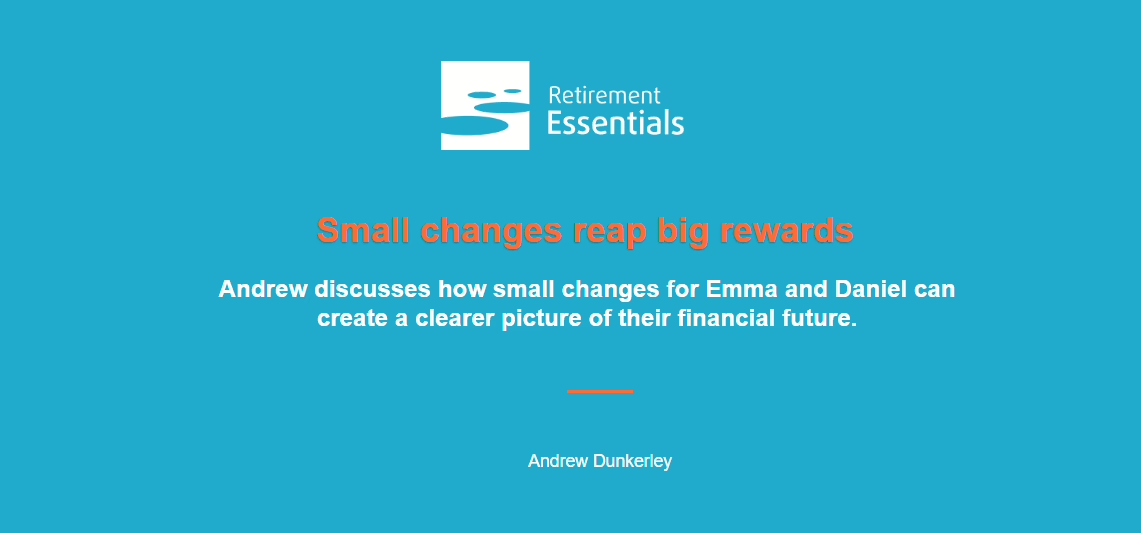
Retirement offers an exciting new chapter in life — but it also often brings a range of financial decisions that aren’t always straightforward. Daniel and Emma recently reached out to Retirement Essentials for much-needed assistance. Their meeting with adviser Andrew Dunkerley gave them clarity, confidence, and a practical plan for their retirement income needs.
Daniel and Emma:
Let the planning begin
Daniel (72) and Emma (63) needed a clearer picture of their financial future. Daniel had $730,000 in superannuation, while Emma had $620,000. They were both still working but on the cusp of retirement, and needed to make pressing decisions about maximising their entitlements. Their primary goal was to optimise Daniel’s Age Pension while refining their superannuation arrangements.
A more focused approach
Andrew’s approach varies from the traditional financial planning model.
Rather than overwhelming clients with a lengthy report, he focuses on addressing one or two key concerns, as clearly and simply as possible. As he puts it,
“Most people have simple retirement needs. Some financial planning organisations will usually assess your entire financial situation, which is costly and time consuming. Many people don’t necessarily need or want this level of service.”
This resonated with Daniel and Emma, who wanted straightforward guidance on managing their superannuation and Age Pension entitlements. They didn’t need a 50-page plan – just practical answers to the questions that mattered most to them.
Getting the most from super and the Age Pension
First Andrew clarified the key difference between the accumulation and drawdown phases of super – namely, the tax treatment and accessibility of funds. While most people benefit from moving into the drawdown phase, in this case, it made sense to leave Emma’s super in accumulation for now in order to increase Daniel’s entitlements.
Andrew also outlined how best to time their contributions, suggesting that they move no more than $120,000 this financial year, then use the full bring-forward cap of $360,000 next financial year. Andrew also provided clear information on how to check Emma’s past contributions via MyGov and how to confirm deposit and withdrawal deadlines with her super fund.
Salary sacrifice was also considered, but given Emma’s income level, it wasn’t worthwhile.
Finding smart strategies and practical actions
While the couple’s primary focus was optimising Daniel’s Age Pension and reviewing their super arrangements, part of the conversation centred around how to correctly report income to Centrelink, especially when it fluctuates.
As Andrew explained,
“Even though Daniel’s entering what he earns every fortnight…, Centrelink requires you to update your entire situation when it changes, such as when your bank balance increases by only a few thousand dollars.”
This was particularly relevant given Emma was transitioning to long service leave on half-pay.
Andrew also introduced a strategy involving Emma’s super. By moving some of their funds into her super account and keeping it in the accumulation phase, Daniel’s Age Pension payments increased. Emma’s accumulation account is not assessable until she reaches Age Pension (AP) age, and whilst Daniel’s pension may decline at that point in time, Emma now becomes eligible for the Age Pension. . It was a clever way to make the system work better for them – but it also involved understanding contribution limits and tax implications.
As a result of the recontribution strategy, Daniel’s Age Pension entitlement increased by approximately $14,000 annually – sum of money he will receive for almost four years until Emma turns 67. As a result, Daniel can keep more of his savings invested and receive the benefits of compounding returns.
Managing cash flow and big expenses
Emma and Daniel were also planning to fund a holiday from their savings and Account-Based Pension accounts, so Andrew discussed the pros and cons of drawing on different sources. He suggested maintaining a separate cash reserve for emergency purposes and short-term planned expenditures like holidays and renovations.
Emma’s unused annual and long service leave entitlements were also discussed. She would still be considered an employee if she received this amount over time. Daniel’s age pension entitlements would be reduced, but she would receive the superannuation guarantee (12% of her base wage from 1 July). Alternatively, she could receive the money as a lump sum and terminate her employment. This would increase Daniel’s pension entitlements, at the expense of any super contribution benefits. Based on Andrew’s calculations, it was better for her to remain employed and receive the Super Guarantee payments.
By the end of the meeting Daniel and Emma knew exactly what to do next:
- check fund cut-off dates to determine when contributions must be received
- stay employed and receive unused annual and long service leave payments
- plan strategic withdrawals and contributions, and
- keep Centrelink updated as their income changes.
What’s next?
Daniel and Emma committed to contact Emma’s super fund to confirm dates and take action before the end of the financial year. If you’re preparing for retirement and wondering whether you’ve set things up the best way, it’s helpful to know that you’re not alone. A short conversation with the right adviser can open the door to better outcomes, less stress, and more confidence in your financial future.
Andrew shares his thoughts

What’s your situation?
Has the experience of Emma and Daniel prompted you to recognise small changes that might work for you as well?
This article is provided by Retirement Essentials Representative Number: 001260855. We are an authorised representative of SuperEd Pty Ltd ABN 88 118 480 907 AFSL #468859. This information is not intended as financial product advice, legal advice or taxation advice. It does not take into account your personal situation, goals or needs and you should assess your own financial situation, consider if the information is suitable for you and ensure you read the relevant Product Disclosure Statement (PDS) if you choose to make any changes to your financial situation. It is always advisable to consult a financial adviser before making financial decisions.






They are so rich that they should not be eligible for an age pension; otherwise, it would be fraud and greed.
they are both working, have over $1 million in super combined and still able to draw a pension? good luck to them. I’m 80 years old, married but my wife isn’t working and not entitled to a pension. I have $30,000 in super, I work 1 day aweek for a meager amount and Centrelink still take away $200 of my pension. so basically we live on half the age pension. I feel I should be compensated for supporting my wife. Getting a full half pension would help.
This biggest issue for me in applying for an aged pension is 1: my partner is still working full time and 2: if I did apply and receive a partial pension, my partner has to report earnings EVERY fortnight and then my pension payment is adjusted according subject to what my partner earns. This is very unfair (the whole reporting aspect)